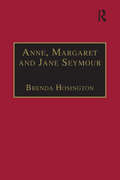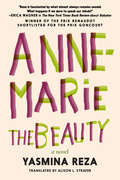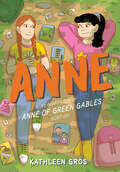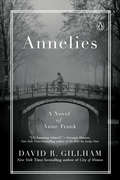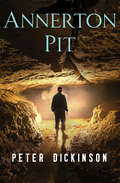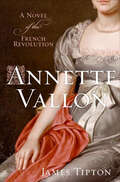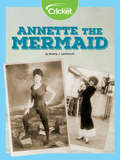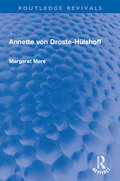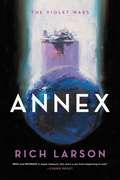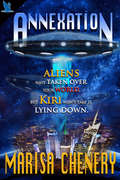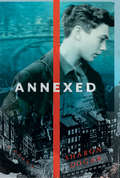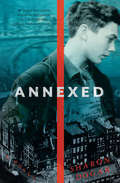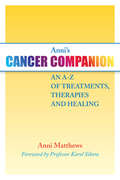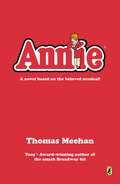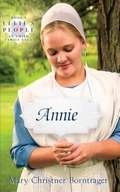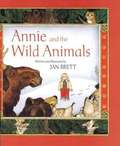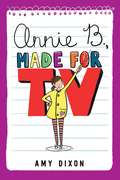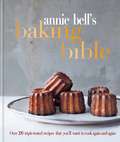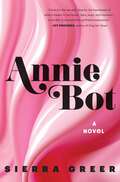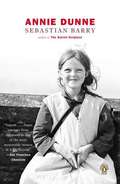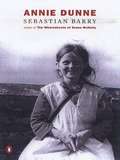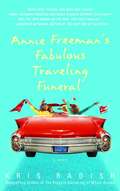- Table View
- List View
Anne, Margaret and Jane Seymour: Printed Writings 1500–1640: Series I, Part Two, Volume 6 (The Early Modern Englishwoman: A Facsimile Library of Essential Works & Printed Writings, 1500-1640: Series I, Part Two)
by Brenda HosingtonDespite the fame their work brought them, and despite the importance of their parents in mid-Tudor England, relatively little is known of the lives of Anne, Margaret and Jane Seymour - daughters of Anne Stanhope and the Duke of Somerset. In 1550, aged roughly eighteen, sixteen and nine, these three noblewomen composed a Latin poem of 104 distichs on the death of Marguerite de Navarre, which they sent to their former tutor, Nicolas Denisot, now living in Paris. Entitled Annae, Margaritae, Janae, Sororum virginum heroidum anglarum, in mortem Divae Margaritae Valesiae, navarrorum Reginae, Hecatodistichon, it was the first formal and original verse encomium in Latin penned by a female author to be printed in England. The Hecatodistichon was published in Paris in 1550 by Denisot, as the cornerstone of a collective tumulus, or commemorative volume, dedicated to Marguerite. The French literati were swift to respond to the appearance of the volume. In 1551 Denisot republished the Seymour's poem in a completely new volume with a French title that emphasised the collective nature of the Tombeau volume. Both volumes are reproduced here from editions held at the British Library.
Anne-Marie the Beauty
by Yasmina RezaAnother thought-provoking master class in how we perform life by the award-winning novelist and playwright Yasmina Reza."I was bored with my husband," says Anne-Marie, the irrepressible voice of Anne-Marie la Beauté, "but you know, boredom is part of love." Mostly she is speaking here of her more famous friend and colleague, the French actress Giselle Fayolle, in whose shadow she has spent her career. "My life was a near miss," she adds, before explaining that she enunciated well because "I loved to say the words." A very short novel with the power and resonance of a much longer one, Anne-Marie la Beauté is a profound and moving act of remembrance, a clear-eyed assessment of the hard-edged nature of fame, a meditation on aging--and a wonderfully observant and comic exploration of human foibles. In short, another thought-provoking master class in how we perform life by the peerless Yasmina Reza.
Anne: An Adaptation of Anne of Green Gables (Sort Of)
by Kathleen GrosIn this modern graphic novel retelling of Anne of Green Gables from graphic novelist Kathleen Gros, foster kid Anne Shirley finally lands in a loving home and befriends a girl who she may have more-than-friends feelings for.Anne Shirley has been in foster care her whole life. So when the Cuthberts take her in, she hopes it’s for good. They seem to be hitting it off, but how will they react to the trouble that Anne can sometimes find herself in . . . like accidentally dyeing her hair green or taking a dangerous dare that leaves her in a cast?Then Anne meets Diana Barry, a girl who lives in her apartment building, the Avon-Lea. The two become fast friends, as Anne finds she can share anything with Diana. As time goes on, though, Anne starts to develop more-than-friends feelings for Diana.A new foster home, a new school, and a first-time crush—it’s a lot all at once. But if anyone can handle life’s twists and turns, it’s the irrepressible Anne Shirley.
Annelie's Raw Food Power
by Annelie WhitfieldRaw food recipes and medicines for everyday life! Inspired by author Annelie Whitfield's time in the lush jungles of Costa Rica, this cookbook explores the wonderful tastes and unique benefits of using raw foods in everyday cooking. Her flavorful raw food recipes and remedies are filled with vibrant and all-natural ingredients that promote whole body wellness and increase energy levels. From healing teas and tinctures to nourishing dinners and beverages, you will feast upon the simplicity of recipes, like: Gingered watermelon juice Pineapple and cucumber gazpacho Wild green salad and citrus tahini dressing Mango, avocado, and tomato burritos Almond crunch cookies Filled with beautiful full-color photographs, Annelie's Raw Food Power shows you that you don't have to sacrifice taste to benefit from this healthy, plant-based lifestyle.
Annelie's Raw Food Power: Supercharged Raw Food Recipes and Remedies
by Annelie WhitfieldRaw food recipes and medicines for everyday life!Inspired by author Annelie Whitfield's time in the lush jungles of Costa Rica, this cookbook explores the wonderful tastes and unique benefits of using raw foods in everyday cooking. Her flavorful raw food recipes and remedies are filled with vibrant and all-natural ingredients that promote whole body wellness and increase energy levels. From healing teas and tinctures to nourishing dinners and beverages, you will feast upon the simplicity of recipes, like:Gingered watermelon juicePineapple and cucumber gazpachoWild green salad and citrus tahini dressingMango, avocado, and tomato burritosAlmond crunch cookies Filled with beautiful full-color photographs, Annelie's Raw Food Power shows you that you don't have to sacrifice taste to benefit from this healthy, plant-based lifestyle.
Annelies: A Novel
by David R. GillhamA powerful and deeply humane new novel that asks the question: What if Anne Frank survived the Holocaust? The year is 1945, and Anne Frank is sixteen years old. Having survived the concentration camps, but lost her mother and sister, she reunites with her father, Pim, in newly liberated Amsterdam. But it’s not as easy to fit the pieces of their life back together. Anne is adrift, haunted by the ghosts of the horrors they experienced, while Pim is fixated on returning to normalcy. Her beloved diary has been lost, and her dreams of becoming a writer seem distant and pointless now. As Anne struggles to overcome the brutality of memory and build a new life for herself, she grapples with heartbreak, grief, and ultimately the freedom of forgiveness. A story of trauma and redemption, Annelies honors Anne Frank’s legacy as not only a symbol of hope and perseverance, but also a complex young woman of great ambition and heart. Anne Frank is a cultural icon whose diary painted a vivid picture of the Holocaust and made her an image of humanity in one of history’s darkest moments. But she was also a person—a precocious young girl with a rich inner life and tremendous skill as a writer. In this masterful new novel, David R. Gillham explores with breathtaking empathy the woman—and the writer—she might have become.
Annerton Pit
by Peter DickinsonA blind boy and his brother set out on a motorcycle in search of their ghost-hunting grandfather It all starts with the postman. Jake cannot see the mail, but he is an excellent listener, and he can tell by the sound the mail makes when it hits the floor that bad news is coming. At the top of the pile is a very thin letter rejecting Jake’s brother, Martin, from every college he applied to. Even worse, there is no news from their grandfather, an eccentric ghost hunter whose supernatural investigations have carried him into the wilds of northern England. Martin cashes in his college savings to buy a secondhand motorcycle, and the boys set out to find their grandfather. It is a trip that will change their lives forever. This ebook features an illustrated personal history of Peter Dickinson including rare images from the author’s collection.
Annette Vallon: A Novel of the French Revolution
by James TiptonFor fans of Tracy Chevalier and Sarah Dunant comes this vibrant, alluring debut novel of a compelling, independent woman who would inspire one of the world's greatest poets and survive a nation's bloody transformation.Set amid the terror and excitement of the French Revolution, James Tipton's evocative novel is the story of a woman who has for too long been relegated to the shadows of history: Annette Vallon, William Wordsworth's mistress and muse.Born into a world of wealth and pleasure, Annette enjoys the privileges of aristocracy, but a burning curiosity and headstrong independence set her apart. Spoiled by the novels of Rousseau, she refuses to be married unless it is for passion. Yet the love she finds with a young English poet will test Annette in unexpected ways, bringing great joy and danger in a time of terror and death. Told in sparking prose, Annette Vallon captures the courage and fearlessness of a woman whose dramatic story illuminates a turbulent and fascinating era.
Annette the Mermaid
by Beverly J. LetchworthThe idea that physical exercise is good for men and women alike is something we take for granted today, but people didn’t always believe this was true. There was a time when exercise was not considered proper or healthy for women. Thanks to athletes like Annette Kellerman, women have come a long way since then.
Annette von Droste-Hülshoff (Routledge Revivals)
by Margaret MareFirst published in 1965, Annette von Droste-Hülshoff is the first book about the great German poetess of the early nineteenth century in English. Delicate, fey, over-sensitive, unstable, with the intellect often described as unbecomingly masculine, it is easy to see how Annette von Droste-Hülshoff was bound to flout the conventions of the conservative society she lived in and to suffer accordingly. But melancholy and despairing as many of her poems are, we are never allowed to imagine her as a weak person. Margaret Mare is careful to show us her trenchant humour, her gift of mimicry, her generosity to her friends, the resolution which made her refuse, in the middle of a dangerous illness, to treat herself ‘like a soap bubble or a soft egg’—giving us a full picture of the woman of genius who could prophesy confidently that her works would still be read a hundred years after her death. Divided into three parts the book deals with the poet’s life and background, detailed interpretations of selected poems, and, the poet’s treatment of supernatural themes, her epics and prose works, her style and use of images. This book will be an essential read for scholars and researchers of poetry, literature, German literature, European literature, and comparative literature.
Annex (The Violet Wars #1)
by Rich LarsonIn Rich Larson's astonishing debut Annex, only outsiders can fight off the true aliens.At first it is a nightmare. When the invaders arrive, the world as they know it is destroyed. Their friends are kidnapped. Their families are changed.Then it is a dream. With no adults left to run things, Violet and the others who have escaped capture are truly free for the first time. They can do whatever they want to do. They can be whoever they want to be. But the invaders won't leave them alone for long...This thrilling debut by one of the most acclaimed short form writers in science fiction tells the story of two young outsiders who must find a way to fight back against the aliens who have taken over her city.
Annexation
by Marisa CheneryPreviously published (2016) Forever More Publishing. Kiri has had the same dream for four years since she was twelve. She travels to another planet, where she meets a boy who teaches her to fight. Always bruised come morning, she knows it's no ordinary dream.After two years of no longer dreaming of Cax, she questions if she hadn't made him up. Then spaceships appear all over the world, and the boy she once knew is among the alien invaders.Orphaned and alone, Kiri uses the skills Cax had given her against his own people, wishing to hurt them as they'd hurt her. The flames of rebellion are fanned ever higher, and Kiri has a role to play that could cost her everything.
Annexed
by Sharon DogarEveryone knows about Anne Frank and her life hidden in the secret annex - but what about the boy who was also trapped there with her? In this powerful and gripping novel, Sharon Dogar explores what this might have been like from Peter's point of view. What was it like to be forced into hiding with Anne Frank, first to hate her and then to find yourself falling in love with her? Especially with your parents and her parents all watching almost everything you do together. To know you're being written about in Anne's diary, day after day? What's it like to start questioning your religion, wondering why simply being Jewish inspires such hatred and persecution? Or to just sit and wait and watch while others die, and wish you were fighting. As Peter and Anne become closer and closer in their confined quarters, how can they make sense of what they see happening around them? Anne's diary ends on August 4, 1944, but Peter's story takes us on, beyond their betrayal and into the Nazi death camps. He details with accuracy, clarity and compassion the reality of day to day survival in Auschwitz - and ultimately the horrific fates of the Annex's occupants.
Annexed
by Sharon DogarEveryone knows about Anne Frank and her life hidden in the secret annex but what about the boy who was also trapped there with her?In this powerful and gripping novel, Sharon Dogar explores what this might have been like from Peters point of view. What was it like to be forced into hiding with Anne Frank, first to hate her and then to find yourself falling in love with her? Especially with your parents and her parents all watching almost everything you do together. To know youre being written about in Annes diary, day after day? Whats it like to start questioning your religion, wondering why simply being Jewish inspires such hatred and persecution? Or to just sit and wait and watch while others die, and wish you were fighting.As Peter and Anne become closer and closer in their confined quarters, how can they make sense of what they see happening around them?Annes diary ends on August 4, 1944, but Peters story takes us on, beyond their betrayal and into the Nazi death camps. He details with accuracy, clarity and compassion the reality of day to day survival in Auschwitz and ultimately the horrific fates of the Annexs occupants.
Anni's Cancer Companion: An A-Z of Treatments, Therapies and Healing
by Karol Sikora Rob Stepney Anni MatthewsWhen Anni Matthews was diagnosed with cancer, she decided to do something really valuable with the experience: she produced a book that is a friendly companion for those who must face the disease. Of huge practical help to anyone diagnosed with cancer and those who care for them, this book is a one-stop guide to making sense and use of the orthodox treatments, complementary therapies, and psychological, spiritual and holistic options available. Subjects ranging from the most current major advances in treatments and diagnosis to the small but effective ways of relieving the side-effects are explained clearly and concisely, often with humour and always with warmth. Written by a bright, articulate woman, who was determined to have an informed say in what happened to her, Anni's Cancer Companion marks a new generation of books about cancer. It is that rare thing: a reference book that is human.
Annie
by Thomas MeehanIt's a hard-knock life for America's favorite orphan! Everyone knows the story of the irrepressible Annie, who lives at Miss Hannigan's orphanage until she beats the odds and finds a new life with the benevolent and wealthy Daddy Warbucks. Annie has enchanted millions of readers from her original comic strip appearance to the hit Broadway musical. Now, with a Tony-nominated revival playing on Broadway, Puffin is reissuing this novelization of the classic story, with a new introduction by Tony and Emmy Award-winning author Thomas Meehan. This is an adaptation that delves even deeper into Annie's story, as she lives on the streets during the Great Depression, finds Sandy the dog, and encounters characters both familiar and new.
Annie (Ellie's People Ser. #10)
by Mary Christner BorntragerAn Amish family opens their hearts and home to a deserted child, Pearlie Mae. They change her name to Annie and raise her in the Amish way. Annie keeps wondering if her birth mother will ever come back. She finds love and security with the Troyers, but not all is well. Lucy is jealous of the attention Annie receives. Annie runs to her mother's Leaning Tree and looks to God's Hills for help. Later Annie works for families as a baby-sitter and maid. She joins the Amish church and goes to youth singings. Boys keep asking to give her rides--till a beau declares himself. With compassion from the Amish community, Annie at last finds her own home. This book completes the Ellie's People series of ten popular volumes by Mary Christner Borntrager. All of them are available in the Bookshare library. Look for: #1. Ellie, #2. Rebecca, #3. Rachel, #4. Daniel, #5. Reuben, #6. Andy, #7. Polly, #8. Sarah and #9. Mandy.
Annie And The Wild Animals
by Jan BrettWhen Annie's cat disappears, she attempts friendship with a variety of unsuitable woodland animals. The borders of the pages foretell the emergence of spring and the birth of kittens.
Annie B., Made for TV
by Amy DixonFor every kid who's ever come in second place, this is a middle grade story about chasing your dreams.Eleven-year-old Annie Brown is used to being on the losing end of comparisons to her almost-always best friend Savannah. Savannah is MVP of the track team, has straight As, and, predictably, wins the most coveted school spirit award on the last day of 5th grade. Fortunately, Annie does have one very specialized skill. Inspired by As Seen on TV commercials, Annie likes to invent products and write clever sales pitches to go along with them. So when an opportunity arises to audition for a local web show called The Cat's Meow, Annie knows her future is set. She's going to wow those producers with her fabulous writing and made-for-TV announcer voice. Of course, things don't happen quite according to plan, and soon Annie is worried about losing both the opportunity she's been training for her whole life, and her best friend.
Annie Bell's Baking Bible: Over 200 triple-tested recipes that you'll want to cook again and again
by Annie Bell'Whatever book Annie Bell writes is always sure to contain recipes I want to cook.' - Nigella Lawson 'Annie Bell is a bright light among Britain's food writers.' - Nigel Slater In this beautiful book, Annie Bell explains the techniques that produce perfect results every time, covering recipes from cakes, brownies and meringues, to tarts, pies and pancakes. With sweet treats for all occasions, Annie shares triple-tested recipes that will ensure your cakes never fail to rise and your pastry is always perfect. From The Ultimate Chocolate Brownies, Rocky Road Slab and Cherry Pound Cake to Tiramisu Torte, Retro Lemon Cheesecake and Big and Fruity Scones, with over 200 delicious recipes packed into one practical volume, this is an indispensable guide to becoming a brilliant baker. It is the only baking book you will ever need.
Annie Bell's Baking Bible: Over 200 triple-tested recipes that you'll want to cook again and again
by Annie Bell'Whatever book Annie Bell writes is always sure to contain recipes I want to cook.' - Nigella Lawson 'Annie Bell is a bright light among Britain's food writers.' - Nigel Slater In this beautiful book, Annie Bell explains the techniques that produce perfect results every time, covering recipes from cakes, brownies and meringues, to tarts, pies and pancakes. With sweet treats for all occasions, Annie shares triple-tested recipes that will ensure your cakes never fail to rise and your pastry is always perfect. From The Ultimate Chocolate Brownies, Rocky Road Slab and Cherry Pound Cake to Tiramisu Torte, Retro Lemon Cheesecake and Big and Fruity Scones, with over 200 delicious recipes packed into one practical volume, this is an indispensable guide to becoming a brilliant baker. It is the only baking book you will ever need.
Annie Bot: A Novel
by Sierra Greer"Provocative...a Frankenstein for the digital age...a rich text about power, autonomy, and what happens when our creations outgrow us." — Esquire"Unexpected and subtle...delicious and thought-provoking." — New ScientistFor fans of Never Let Me Go and My Dark Vanessa, a powerful, provocative novel about the relationship between a female robot and her human owner, exploring questions of intimacy, power, autonomy, and control.Annie Bot was created to be the perfect girlfriend for her human owner Doug. Designed to satisfy his emotional and physical needs, she has dinner ready for him every night, wears the pert outfits he orders for her, and adjusts her libido to suit his moods. True, she’s not the greatest at keeping Doug’s place spotless, but she’s trying to please him. She’s trying hard.She’s learning, too.Doug says he loves that Annie’s AI makes her seem more like a real woman, so Annie explores human traits such as curiosity, secrecy, and longing. But becoming more human also means becoming less perfect, and as Annie’s relationship with Doug grows more intricate and difficult, she starts to wonder: Does Doug really desire what he says he wants? And in such an impossible paradox, what does Annie owe herself?
Annie Dunne
by Sebastian Barry"The central character in Sebastian Barry's novel Annie Dunne is a woman who has been pushed to the margins, a woman whom life has given few chances of happiness and fulfillment. Unmarried, she spends years as housekeeper for her brother-in-law because her sister is too ill to manage. Her sister dies, her brother-in-law remarries, and Annie Dunne is homeless. Invited by her cousin Sarah, she moves to a small farm in a remote part of Wicklow. As the novel opens, the two cousins share their lives and the work on the farm. It is the late 1950s and rural Ireland is changing around them. Annie's nephew heads for London in search of work and leaves his young children with their great-aunt. Content with her life with Sarah, Annie also finds a new capacity for love in her feelings for the two children. Yet even the small pleasures that Annie finds in her life are threatened. An unlikely suitor pays court to Sarah, and Annie's love for the children opens her up to pain almost as much as to happiness. Annie Dunne is a novel in which few external dramas occur--there is an accident with a pony and trap, one of the children goes temporarily missing--but Barry evokes superbly the inner dramas of his characters. In a society where emotions are often severely repressed and expressed only obliquely, small incidents hint at larger feelings and Barry has written a story in which these are subtly and poignantly unfolded." --Nick Rennison, Amazon.co.uk
Annie Dunne
by Sebastian BarryAnnie Dunne and her cousin Sarah live and work on a small farmin a remote and beautiful part of Wicklow in late1950s Ireland. All about them the old green roads are being tarred, cars are being purchased, a way of life is about to disappear. Like two old rooks, they hold to their hill in Kelsha, cherishing everything. When Annie's nephew and his wife are set to go to London to find work, their two small children, a little boy and his older sister, are brought down to spend the summer with their grand-aunt. It is a strange chance of happiness for Annie. Against that happiness moves the figure of Billy Kerr, with his ambiguous attentions to Sarah, threatening to drive Annie from her last niche of safety in the world. The world of childish innocence also proves sometimes darkened and puzzling to her, and she struggles to find clear ground, clear light - to preserve her sense of love and place against these subtle forces of disquiet. A summer of adventure, pain, delight and ultimately epiphany unfolds for both the children and their elderly caretakers in this poignant and exquisitely told story of innocence, loss and reconciliation.
Annie Freeman's Fabulous Traveling Funeral: A Novel
by Kris RadishThe bestselling author of "Dancing Naked at the Edge of Dawn" introduces five singular women about to embark upon a most remarkable--and inspiring--journey.
